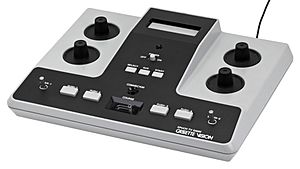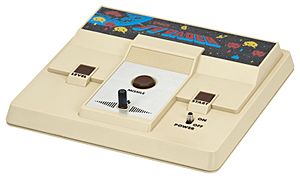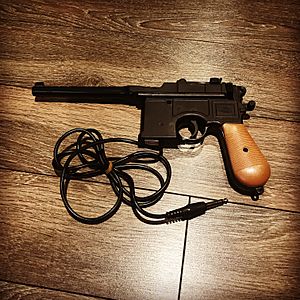Cassette Vision facts for kids
 |
|
| Manufacturer | Epoch |
|---|---|
| Type | Home video game console |
| Generation | Second generation |
| Release date |
|
| Introductory price | ¥13,500 ($61) |
| Discontinued | August 1984 |
| Units sold | c. 400,000 |
| CPU | NEC uPD77xx |
| Removable storage | ROM cartridge |
| Display | 54 x 62, 8 colors |
| Graphics | µPD778 |
| Sound | Beeper |
| Input | Internal controllers |
| Predecessor | TV Vader |
| Successor | Super Cassette Vision |
The Cassette Vision was a second generation home video game console. It was created by Epoch Co. and launched in Japan on July 30, 1981. Later, a new version called the Cassette Vision Jr. was released.
The word cassette here means a ROM cartridge, which is like a small computer chip that holds games. It's not like the old magnetic cassette tapes. The Cassette Vision was similar in power to the Atari 2600. It had unique controls built right into the console. There were four knobs, two for each player, to move things horizontally and vertically. Each player also had two buttons.
The Cassette Vision first sold for ¥13,500. Games cost ¥4,000 each. About 400,000 units were sold. It was the best-selling video game console in Japan for a while. This was before Nintendo's Family Computer became popular. The Cassette Vision later got a new version called the Super Cassette Vision. This newer console was more like the Famicom and Sega's SG-1000 systems. There was even a special pink version for girls called the Super Lady Cassette Vision. It came with a carrying case and a game called "Milky Princess."
History of the Cassette Vision
Epoch was founded in 1958 by Maeda Taketora. They first made plastic baseball boards. Then, they started making toys, board games, and playing cards. Epoch became one of Japan's biggest toy companies in the 1960s and 1970s. This was partly because it was a family-run business.
In 1975, Epoch worked with Magnavox to release the TV Tennis Electrotennis. This was the first video game console ever released in Japan. In 1980, Epoch released the TV Vader. This console had a game similar to Space Invaders. It was quite successful. Because of their experience with electronic games, Epoch started making a console that used interchangeable ROM cartridges. These cartridges would let players switch games.
Masayuki Horie, an Epoch designer, was in charge of the Cassette Vision. He had worked on earlier consoles for the company. Epoch wanted the Cassette Vision to be the best of their past console designs. They especially wanted it to be cartridge-based. This would save space in people's homes, as their older consoles were often big.
The Cassette Vision was not the first cartridge console in Japan. Other companies like Takatoku Toys and Bandai had released some earlier. Epoch's team faced a challenge. They couldn't separate the game's memory (ROM) from the main computer chip (CPU) in the console.
The Cassette Vision was released in Japan on July 30, 1981. It cost ¥13,500. Epoch used a marketing plan similar to what Atari did with its Video Computer System. Atari's console was released in Japan by Epoch as the Cassette TV Game. The Cassette Vision quickly became popular. It was the best-selling game console in Japan at that time. By 1982, it held 70% of the market. Horie thought its success was because it was easy to use and appealing to many people.
Epoch had trouble making enough consoles because of the costs. So, on July 19, 1983, they released the Cassette Vision Jr. This was a cheaper, smaller version. It cost only ¥5,000. The Jr. model kept most features of the original. It removed the volume dial and changed the button layout. This made some games easier to play. The Cassette Vision Jr. was also very successful because of its low price.
Just four days before the Jr. was released, Nintendo launched the Family Computer (Famicom). The Famicom also used interchangeable cartridges. It quickly became more popular than the Cassette Vision. The Famicom could make arcade games like Donkey Kong look very good. The Cassette Vision couldn't compete with the Famicom or Sega's SG-1000. Its hardware was not as powerful.
Epoch stopped making the Cassette Vision in August 1984 because sales were low. Its last game, Elevator Panic, came out that same month. Epoch then focused on making a new console to compete with Nintendo and Sega. This became the Super Cassette Vision. In total, about 400,000 Cassette Vision units were sold.
Games for the System
There were twelve games made for the Cassette Vision:
- 1. Kikori no Yosaku
- 2. Baseball – a baseball game released in 1981. This game was also available on an older Epoch console called TV Baseball.
- 3. Galaxian – This game was inspired by Moon Cresta, not the famous Namco game.
- 4. Big Sports 12 – a sports game released in 1981.
- 5. Battle Vader – a shooting game released in 1982. This game was also on the 1980 console TV Vader.
- 6. PakPak Monster – This game was inspired by Pac-Man.
- 7. New Baseball
- 8. Monster Mansion – This game was inspired by Donkey Kong.
- 9. Astro Command – an action game released in 1983. It was inspired by Scramble.
- 11. Monster Block – This game was inspired by Pengo.
- 12. Elevator Panic
Accessory
Epoch also released a Lightgun for the Cassette Vision. It came out the same year as the console. This gun was used with the Big Sports 12 game cartridge. That cartridge had 12 games, and 4 of them needed the light gun to play. The gun connected to the console using a special port. This was the only accessory for the Cassette Vision. When the Cassette Vision Jr. was released, this port was removed. This meant the light gun could not be used with the Jr. model.
Technical Details
Epoch decided to use a special computer chip called the NEC uPD77xx. They had used this chip for earlier games like TV Baseball and TV Vader. For the Cassette Vision, Epoch put the main computer chip (CPU) directly inside the game cartridge. The console itself only held the power supply, the controls, and the parts for video and sound. This design allowed the games to run faster. It also helped keep the cost of the console lower.
See also
 In Spanish: Epoch Cassette Vision para niños
In Spanish: Epoch Cassette Vision para niños




